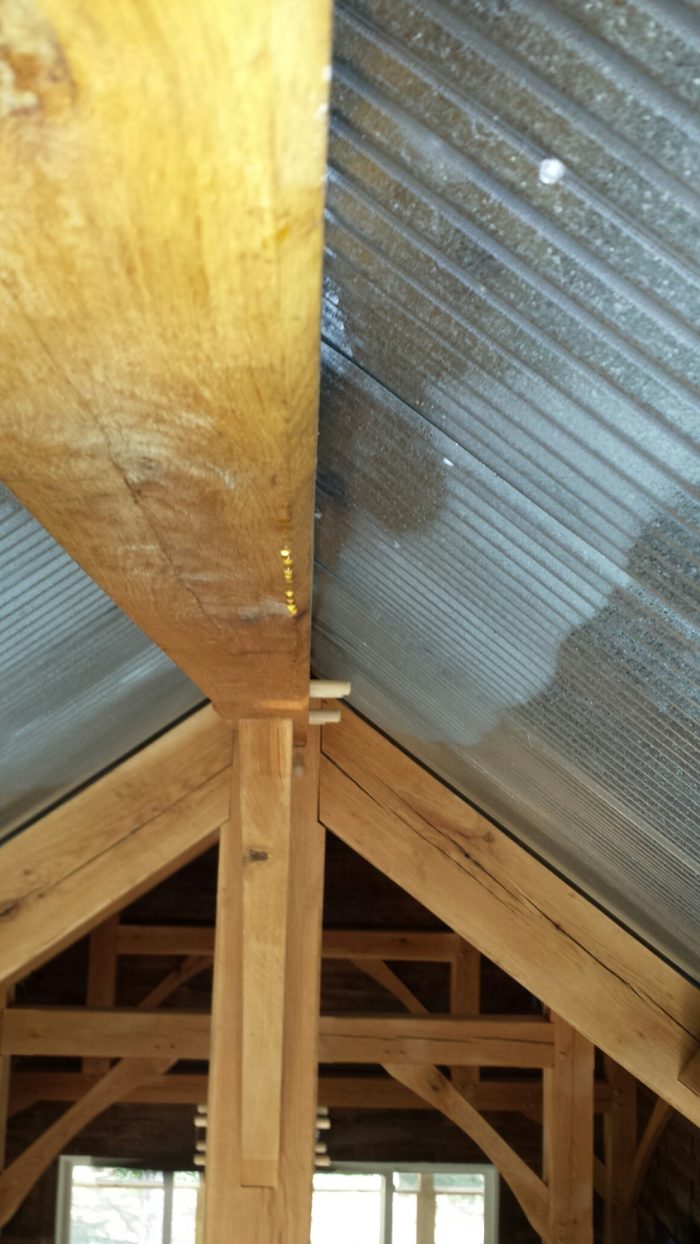
Image Credit: Jeremy Ballard
Jeremy Ballard is living in a relatively new home built with structural insulated panels (SIPs), and he’s already spotted something that’s keeping him up at night. The weather in Kentucky is turning hot and humid, and with the humidity has come condensation on corrugated metal panels installed on the interior of the roof.
“Our center ceiling beams are dripping wet throughout the day, causing small puddles on the floor,” Ballard writes in a post in the Q&A forum at GreenBuildingAdvisor. “The ceiling is hot to the touch at the very peak on either side of the center beam. I believe hot outside air is leaking in.”
As he starts a round of calls to his builder, the SIP manufacturer, and the manufacturer that provided the frame, Ballard looks for recommendations on how the problem can be corrected. Seams between SIPs are not taped, either on the inside or the outside, and they’re now inaccessible. Other possible clues: the unvented metal roofing is installed over furring strips and a layer of “double bubble,” a foil-faced product sold as insulation.
Another question faced by Ballard: Who’s responsible for making it right? Among the candidates are the general contractor for the house, the manufacturer of the SIPs, and possibly himself.
“I couldn’t sleep last night thinking how this cost our family over $32,000 for the SIPs and the first summer [they] are failing,” Ballard says.
That’s the topic for this Q&A Spotlight.
Yes, air leaks are the culprit
David Meiland has no doubt the problem is a leaky roof assembly. “As you allude to, the issue is probably air leakage and the solution is to seal the joints where air is leaking in,” he writes.
If the builder responds to Ballard’s requests for help,…
Weekly Newsletter
Get building science and energy efficiency advice, plus special offers, in your inbox.

This article is only available to GBA Prime Members
Sign up for a free trial and get instant access to this article as well as GBA’s complete library of premium articles and construction details.
Start Free TrialAlready a member? Log in















One Comment
Tropuble on the Roof
I agree with Peter on this one, specifically, his post suggests there is likely more than one contributor to the condensation issue. Having seen this condition many times, (especially on metal roof systems)and without the use of SIP's, I have diagnosed multiple conditions that have influenced condensing:
Air leaks are generally a prominent contributor, temperature differential between the cool metal surface on the conditioned side and the warmer surface on the bottom of the SIP panels, (is there enough insulation above the roof to prevent this in extreme conditions), as mentioned the HVAC system may not be sized or installed correctly, (or both) and cannot handle the RH, let's not forget occupant behavior as well.
If it were my building, I would conduct a complete diagnosis before attempting any trial and error tactics; this may provide a more focused approach. A ventilation system was not mentioned in any of the posts. A balanced ventilation system like an ERV may be appropriate although after the fact installation may be difficult.
I would also be concerned about the condition, especially at the seams, of the SIP's. Remember the Juneau AK SIP roof failures? These were do to improper joint sealing and taping. Sealing and taping from the top side of the SIP may be problematic. I'm just thinking about pressures on the conditioned side (possibly) being greater than that of the roof side except in high wind conditions. My concern is that if the SIP's are sealed and taped from the top and moisture is transferred from in to out, what is the drying potential at the seam. At least if the panel seams were sealed from the under side, (not possible in this application) I'm guessing the seam would have a greater potential to dry.
Let us not forget the "house as a system" concept: many systems are involved all having to work in compliment with each other to manage the conditioned space. I'd appreciate any comments on my thinking. It's all educated guesswork.
Log in or become a member to post a comment.
Sign up Log in